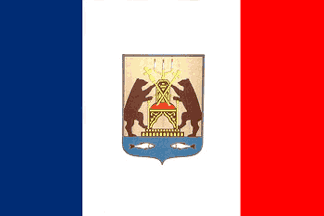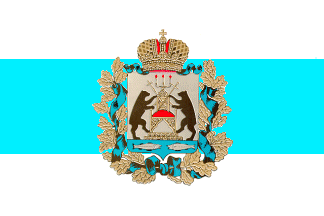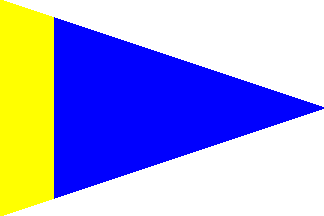
image by Jens Pattke, 21 Dec 2007

Last modified: 2014-05-29 by zoltán horváth
Keywords: novgorod | velikiy novgorod | informal flag | no flag | fish (white) | fish: 4 | throne | coat of arms | mural crown: red | triangular | matvhenko (ûriĭ) | cleanliness | volqov |
Links: FOTW homepage |
search |
disclaimer and copyright |
write us |
mirrors

image by Jens Pattke, 21 Dec 2007
(Note: You need an Unicode-aware software and font to correctely view the cyrillic text on this page. See here transliteration details).
I’d like to once again stress the point that
Novgorod and
Niẑniĭ Novgorod
are two completely different cities,
both regional capitals. Novgorod was recently
renamed Velikiĭ Novgorod;
and Niẑniĭ Novgorod
was named Gorhkiĭ | Горький
(a.k.a. Gorky) from 1932 to
approx. 1992.
António Martins, 21 Feb 1999
"Niẑni | Нижний" means "Lower",
"Veliki | Велики" means "Great".
Gvido Pētersons, 22 Feb 1999

I have received information from Mr. Kopyl about flag
of Novgorod oblast (regional) government. Novgorod
oblast have not official flag. The Novgorod oblast
have arms only. But you can use the flag with white-blue-white
stripes with coat of arms at the center,
as informal flag of Novgorod oblast.
Anatoly Nikiforov, by way of
Pascal Gross, 31 May 1999
At the end of 90 acceptance of standart the
governor was extended. Such standarts were accepted in the Novgorod
area.
Sergey Filatov, 10 Oct 2005
Most of these flags are squarish (about 11:12),
rigid and fringed variants of the region (Governors) or Republic (Presidents)
flags with the regional emblem over all.
António Martins, 02 Oct 2005
Argent a throne with three candles on chief and a sceptre and
episcopal cross in saltire all proper, dexter and sinister two bears
respectant sable, on a base azure two fish naiant respectant argent.
Santiago Dotor, 04 Dec 1998

At the Novgorod city history museum I did saw a
battle flag carried in the wars against Sweden in the
early 1600’ies: It was a square canvas banner with a
saltire and border, no fringe, and over all a much
smaller red saltire. This latter element might have
been added later, since it was rather coarsely stiched
(while the other stich lines were impeccable) and it’s
color wasn’t faded out. The saltire and the border
seemed to have the same color, while the backgrond
(four triangles) were of a second color: I
reconstructed them as white and blue, but in the actual
flag they are faded to two shades of very whitish
brown. The explanation text wasn’t conclusive about
all this.
António Martins, 15 Nov 1999

The historical flag of Novgorod is blue triangle
with yellow vertical stripe in the hoist. Then the
colors of Novgorod are historically yellow and blue,
but in the current flag is
white-blue-white.
Jaume Ollé, 07 Nov 1997
I was in the city history museum and I saw no
evidence about this flag.
António Martins, 15 Nov 1999

It is horizontaly white-blue-white, with
the coat of arms.
Jordi Pérez, 05 Nov 1997
The flag of Great Novgorod city was officially authorized by Decision of the Chapter of Administration of city of Novgorod from 14.04.1994 N 57 About the flag of Novgorod city. The author is architect Yuri Matvienko. Official symbolism:
This flag uses in the central stripe and on the coat of
arms the same shade of (medium) blue used on the russian national flag
(and not light blue) and the three stripes are of equal width (and not
“spanish style”). The embattlements of the mural crown
are "M" shaped and red (maybe with something yellow on them in some
variations), simulating the looks of the local kremlh (citadel)
walls. Please note the way the white field of the coat of arms fits on the
central blue stripe.
António Martins, 15 Nov 1999
It looks like this coat of arms has lost the imperial
crown, ribbon of the Order of St.Andrew and oak leaves
wreath and has incorporated two more fish.
Santiago Dotor, 17 Dec 1998
The city flag is moderately used — I saw it in two
locations on the city, flown along with the russian flag
(but it seemed to me that it was more decoration of
turistic spots rather than ofiicial facilities), and
also in tabletop small size, in the receptions of two
hotels.
António Martins, 15 Nov 1999
Other sites: